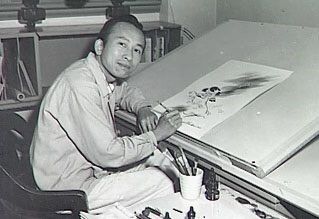Tyrus Wong did not get an obituary here for the very simple reason that his death was upstaged by not one but two people. One of them doubtless would have sympathized, having been upstaged by the other one not infrequently in her own life, but it’s true that a certain mother-daughter pair of deaths in the waning days of 2016—o exhausting year of death—took all the air out of the room for remembering that anyone else might die. Even if that person was a bona fide certified Disney legend before either of the women had a career, before one of them was born or thought of.
Tyrus Wong immigrated to the United States illegally. It was 1920, and it was illegal for Chinese people to immigrate to the US. Wong and his father came as “paper sons,” people claiming to be the children of Chinese people who had immigrated to the US while it was still legal for them to do so. Wong’s mother and sister were left behind, and the family was never to be reunited. Wikipedia claims Wong attended Benjamin Franklin Junior High in Pasadena, but I’ve never even heard of a Benjamin Franklin Junior High in Pasadena and can find no information about it. Pasadena readers?
What is true, however, is that at about that time he received a scholarship to the Otis Art Institute, where he also worked as a janitor. It’s uncertain when he graduated, but it was not long until he was providing the inspiration art for Bambi. Its lovely, lush style is based on traditional Chinese art in a way that would go unappreciated for a long time, not least because Wong was one of the animators fired during the strike. Walt was doubtless not inclined to promote the contributions of someone he’d fired. He then went to work for Warners, where he was frankly also underappreciated.
While I wouldn’t be me if I didn’t mostly remember him for Bambi, let’s talk about his Warners work. Because his Warners work is amazing. How the West Was Won is all by itself a hell of a credit for an art director, but it’s only one of an impressive array. The look of Warners movie musicals owes a lot to Wong, who worked on Camelot, The Music Man, and Gypsy. He worked on both Giant and Rebel Without a Cause. The Great Race. Rio Bravo, Key Largo, and Mildred Pierce. His work was exquisite and influential, even if people didn’t realize they were being influenced by him.
In retirement, he made kites, which is utterly charming. He’d worked for Hallmark, and he continued to paint, but it seems he was a Saturday fixture near Santa Monica Pier, flying the kites he’d made himself. I’ve seen a few pictures, and they are fascinating and elaborate, flying works of art. Immigrants are a major contributor to American history and culture, even if they don’t come in “the right way.” Though of course there was no “right way” for a Chinese immigrant in 1920.
Help keep my kids in art supplies by supporting my Patreon or Ko-fi!

